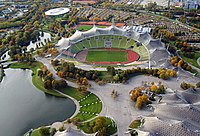Stadium

The Olympic Stadium, home of Bayern Munich from 1972 to 2005
From 1925 Bayern shared the Grünwalder Stadion with 1860 Munich. Until World War II the stadium was owned by 1860 Munich, and is still colloquially known as Sechz'ger ("Sixties") Stadium nowadays. It was destroyed during the war, and efforts to rebuild it resulted in a patchwork. Bayern's record crowd at the Grünwalder Stadion is reported as more than 50,000 in the home game against 1. FC Nuremberg in the 1961–62 season. In the Bundesliga era the stadium had a maximum capacity of 44,000 which was reached on several occasions, but the capacity has since been reduced to 21,272. As was the case at most of this period's stadia, the vast majority of the stadium was given over to terracing. Today the second teams of both clubs play in the stadium.

For Bayern home games the Allianz Arena is lit in red.
After much discussion the city, the state of Bavaria, FC Bayern, and TSV 1860 jointly decided at the end of 2000 to build a new stadium. While Bayern had wanted to build a purpose-built football stadium for several years, the awarding of the FIFA World Cup 2006 to Germany stimulated the discussion as the Olympic Stadium no longer met the FIFA criteria to host a World Cup game. Located on the northern outskirts of Munich the Allianz Arena has been in use since the beginning of the 2005–06 season. Its initial capacity of 66,000 fully covered seats has since been increased for matches on national level to 69,901 by transforming 3,000 seats to terracing in a 2:1 ratio. The most prominent feature of the stadium is the translucent outer layer, which can be illuminated in different colours for impressive effects. Usually red lighting is used for Bayern home games, blue for 1860 home games and white for German national team home games.
0 comments:
Post a Comment